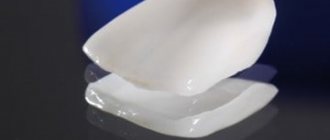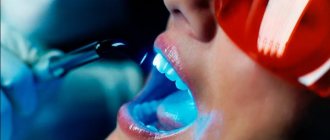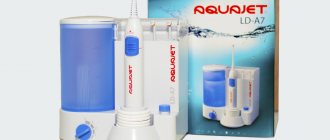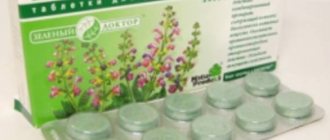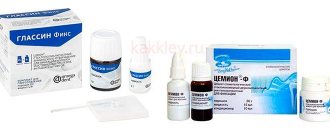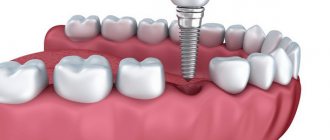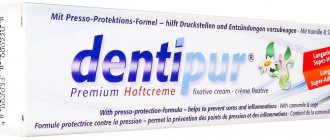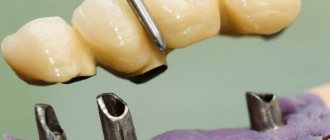In this article we will talk about fixing ceramic restorations, or more precisely, how to properly prepare the surface of a crown or veneer to obtain a reliable bond with the composite or tooth tissue, what materials are used for this and how they work.
All this is also relevant for repairing metal-ceramic and ceramic restorations using the direct method and when fixing bracket systems to a ceramic surface.
First you need to note the materials needed for the work.
- Hydrofluoric acid.
- Primer for ceramics
- Bonding hydrophobic resin
- Adhesive that can be used for indirect restorations
And now the actual stages
Treatment with hydrofluoric acid.
Hydrofluoric acid (HF) is necessary for etching the ceramic surface. As a result, a rough surface is created and the gluing area increases. You can receive a restoration with an already treated surface (etching is done in the laboratory), or you can prepare it yourself. For use in a dental clinic, hydrofluoric acid gels are produced, usually 4% and 9-9.5%. The etching time for different types of ceramics may vary (need to be checked with the manufacturer), on average for feldspathic and leucite glass ceramics 4-6 minutes with 4% hydrofluoric acid and 1-2 minutes with 9%. For e-max® ceramics 20 seconds with 9% hydrofluoric acid. Longer use increases the etching depth, creating a brittle surface layer.
Gels available for dentists are 4% PORCELAIN ETCHANT and 9.5% PORCELAIN ETCHANT (BisCo), IPS Ceramic Etching Gel (Ivoclar Vivadent), Ultradent® Porcelain Etch, etc. Instructions for some of them can be read here. A surface covered with glaze is less susceptible to etching, so a slight roughening of the surface with a diamond bur, disc or sandblasting is required. Due to the fairly high aggressiveness of hydrofluoric acid, when applied in the oral cavity, careful isolation is required, best with the help of a rubber dam. Areas that do not require treatment are isolated using protective materials, which are usually sold in ceramic repair kits, for example BARRIER GEL (BisCo), EtchArrest® (Ultradent). You can also use Mylar matrices or Teflon tape. After pickling, rinse with water for at least 1 minute, or neutralize the acid with sodium bicarbonate solution.
Applying primer for ceramics.
The ceramic primer is an acetone and alcohol based silane. Silane is a dual-function monomer consisting of a silane group that contacts the ceramic surface and a methacrylate group that is embedded in the resin matrix of the composite. This agent allows you to increase the moisture content of the treated surface, while providing better resistance to wear of the bonding surface from the influence of liquids.
In other words, the primer penetrates into the etched surface due to the presence of a solvent with high wetting ability, then after drying, the solvent evaporates and methacrylate remains, which in turn is incorporated into the composite resin. After application, wait 60 seconds and dry with a strong stream of air.
Preparations: Monobond® Plus (Ivoclar), PORCELAIN PRIMER (BisCo), Ultradent® Silane, etc.
Primer selection.
The supporting teeth along the preparation margin are etched with 37% phosphoric acid gel for 30 seconds, then the gel is washed off with a stream of water, and the adhesive is applied according to the manufacturer’s instructions. Composite cement Variolink 2 (Ivoclar Vivadent).
Ceramic copings are made using the IPS e.max ZirCAD system (Ivoclar Vivadent), at the next stage an additional layer of IPS e.max ZirCAD fluorapatite glass ceramics is pressed onto the caps, which allows for optimal optical characteristics of the ceramic restoration.
For the manufacture of onlays (inlays) the e.max Ceram system is used.
Treatment of the internal surfaces of ceramic restorations before cementation.
Sandblasting with aluminum oxide powder, washing, drying.
Etching - applying a 10% solution of hydrofluoric acid for 40 seconds, thoroughly rinsing in running water. Precipitated crystals are removed by placing the restoration in an ultrasonic bath for 5 minutes (distilled water or 95% ethanol), it is possible to remove precipitates with a jet of superheated steam (steam jet for 1 minute).
A primer layer of silane is applied to the treated and dried surface for 1 minute.
When cementing full all-ceramic crowns with hydrofluoric acid, only the edge of the restoration along the preparation margin (a layer of ceramic with a high content of silicon oxide) is etched, which avoids adverse changes to the rest of the internal surface, represented by ceramics with a low content of silicon oxide.
Fixation of a metal-free structure in the oral cavity.
It is strongly recommended to isolate the surface of the abutment teeth with a rubber dam. The enamel surface is etched for 30 seconds with 37% phosphoric acid gel, thoroughly washed with a water-air gun, adhesive is applied according to the manufacturer’s instructions, composite cement is added to the ceramic restoration, restoration is installed, excess cement is removed, light polymerization is applied on each side of the restoration for 60 seconds. . Maintain finger pressure on the fixed structure until light polymerization is complete.
Visual and tactile (probe tip) control, careful removal of cement residues from the surface of the tooth and restoration, the presence of a retraction thread will facilitate this manipulation, and revision of the rinsing space.
Polishing the transition boundary between the tooth tissue and the surface of the restoration with special conical rubber bands to reduce abrasiveness.
Checking and correcting occlusal relationships. Leveling of occlusal obstacles during excursion movements of the lower jaw and premature contacts in the position of central occlusion. Grinding of premature contacts with a fine-grained bur, followed by polishing with rubber discs, gradually reducing the grain size (yellow or white markings).
3. Milled structure (CAD-CAM, Prettau) made of ZrO2
Zirconium dioxide is a chemically very strong substance that is not subject to etching with acids (acids do not affect zirconium dioxide, do not waste time, acid and health). The retention of the zirconium structure on the tooth surface is carried out due to micromechanical retention, therefore the optimal choice of luthing cement (IMHO) is glass ionomer cements modified with a composite.
How to improve the fixation of metal-free ceramics to the tooth surface?
Stage one is cleaning the metal-free crown (bridge).
I strongly recommend first (to increase the roughness and improve the microretention of the surface) to treat the inner surface of the crown using the sandblasting method - aluminum oxide powder with a grain size of 50-100-110 microns, cleaning with compressed air, in an ultrasonic bath, supersaturated water vapor, applying silane to the dried surface of the crown Manufacturer's instructions - apply silane (ceramic primer), wait a minute or two, dry the excess. Do not break this sequence!
Stage two. Selection of silane and surface silanization.
I have been using it for many years and recommend Monobond® Plus (Ivoclar-Vivadent), PORCELAIN PRIMER (Bisco), Ultradent® Silane (Ultradent Inc). Options - Porcelain Silan (BJM Lab) - glycidooxypropyl trimethoxysilane 3.0%, ethanol. CLEARFIL Ceramic Primer (Kuraray), Cimara - haftsilane from Voco
Most luting cement kits now come with a silane agent or coupling agent that should be applied directly to the cleaned interior surface of veneers or inlays fabricated in a dental laboratory, or used to repair porcelain restorations.
If the composite cement you purchased does not contain a silanizing agent, silane, this does not mean that there is no need to purchase and use it!!!
N.B.
Before applying silane, it is necessary to thoroughly clean the ceramic surfaces, first with water and then with isopropyl alcohol, acetone or phosphoric acid, especially after trying them in the mouth or use my instructions above. This should be done to remove any surface contaminants, including saliva or blood, that would interfere with the application of the silane coupling agent.
Let's consider alternative options.
Features of the use of luthing cements
- Two-part composite cements: luting indications - Lava™ zirconia crowns, feldspathic glass ceramics and composite nanoceramics (such as Lava™ Ultimate CAD/CAM milling material), must be pre-treated with Single Bond Universal adhesive as silane, feldspathic ceramics after etching and composite nanoceramics after sandblasting only. Bonded to dual-curing RelyX™ Ultimate cement (3M-ESPE).
Self-etching composite cements:- -universal - MaxCem Elite (Kerr), Panavia F 2.0, RelyX™ Ultimate, RelyX™ Luting 2, Breeze® Self-Adhesive Resin Cement (Pentron), GC G-CEM LinkAce,
- for cementing orthopedic structures based on zirconium dioxide ceramics - Zirconite (BJM Lab),
- Fixation of crowns, bridges, inlays and onlays made of conventional ceramics, metal-free ceramics, hybrid ceramics, metal-ceramics and composite structures;
- Fixation of metal and composite stumps - stump inlays (CSI), metal and fiberglass pins, veneers, adhesive bridges.
- PANAVIA V5 (Kuraray) Panavia V5 Tooth Primer provides equally high bond strength during both light and chemical polymerization, thanks to a new patented catalyst + high-quality chemical bond of the MDP monomer. CLEARFIL CERAMIC PRIMER PLUS contains original MDP monomer and γ-MPS silane monomer, for bonding with:
- - ceramics, including lithium disilicate,
- -zircon dioxide,
- -metals,
- -composite.
Panavia F 2.0 (Kuraray) - included in the set ED Primer A, ED Primer B - self-etching primer for hard dental tissues, Metal Primer, Ceramic Primer, dual-curing cement - anaerobic and light.
- Two-component composite cements & buil-up materials Build-It FR is specifically designed to perform:
- — with Bond-1, a one-component bond system for adhesion to dentin, enamel and pins;
- with Bond-1 C&B bond for fixing extended metal ceramics;
- The peculiarity of the material is that it is filled with fiberglass and has high strength, wear resistance, and impact strength.
- Composite cements, by default, are intended for adhesive
fixation of orthopedic structures.
You can achieve adequate adhesive preparation on the surface of the teeth (cleaning and degreasing, drying, etching, applying and polymerizing the adhesive system on the teeth), but it is impossible to fix the adhesive (and, accordingly, the composite luting) on an absolutely smooth zirconium dioxide surface without preliminary thorough preparation of the surface zirconium or other all-ceramic construction.
DO NOT NEGLECT THE MANUFACTURER'S INSTRUCTIONS!
We carefully follow the rules of cleaning, etching, drying, silanizing, adhesive preparation, adding cement, fixing, insulating the perimeter of the fixed structure with protective components - Oxyguard-2 from PANAVIA, for anaerobic polymerization, protective varnish Optiguard (Kerr) or coconut oil (vaseline). This is a feature of luting cements that require an anaerobic polymerization mechanism - PermaCem, Panavia F2.0 and others, or rather, the majority.
Insulation with a hydrophobic coating will not be superfluous to prevent the absorption of moisture by luting cement and improve its mechanical properties! Thus, the cement is firmly attached to the surface of the abutment tooth, but without any connection (chemical or mechanical) with the inner surface of the zirconium denture.
Retention of a crown or bridge only due to the precision of the design and vacuum? Personally, this fact “stresses” me a little. And I cannot recommend composite cements for permanent fixation of orthopedic structures based on zirconium dioxide. Any composite cements, the cost of cement and the manufacturing company (and even more so - your ambitions or lack of necessary knowledge of skills and materials in practice) do not have a “magical effect” on the chemical structure and physical properties of materials.
IMHO - this is my opinion, you can either disagree with it (a matter of faith and attachment to the “favorite cement”), or after thinking about it, you can still agree. 
Application of hydrophobic resin binder.
A hydrophobic resin based on Bis-Gma and dimethacrylates (included in composite resins) allows you to create a bonding film between the ceramics and the composite. Hydrophobicity increases the service life of the fixing cement and the restoration as a whole. Resins are produced for direct use on ceramics, for example PORCELAIN BONDING RESIN (BisCo), and as part of 4th generation adhesives, such as Heliobond (Ivoclar).
If we use a 5th generation adhesive instead of resin, we will get a more hydrophilic film and, over time, pigmented edges of the restoration
You can skip this step and apply the composite directly, but there is a certain degree of risk here. Composite cement filler particles can block micropores created after etching of the ceramic, and the resin will not contact the entire surface. This will of course affect the strength of the ligament.
All that remains is to carry out adhesive treatment of the tooth surface and fix the restoration with composite cement.
We will discuss which adhesives are suitable for indirect ceramic restorations in future articles.
Vitique cement sets for fixing veneers
Fixation of veneers and assistance to specialists
The high-quality materials of the Vitique system give you many practical advantages. For example, the highest color stability ensures a long-term effect of aesthetic restoration.
- A complex of high-quality materials for fixing veneers
- Wide range of shade shades
- Exact matching of the color shades of the fitting paste and cement
- Easy removal of excess
- High color stability
- The set includes detailed illustrated instructions for use
Indications:
Reliable aesthetic fixation of ceramic and composite veneers.
Benefits for your work with veneers
The high-quality materials of the Vitique system give you many practical advantages. For example, the highest color stability ensures a long-term effect of aesthetic restoration. Other key benefits:
- Vitique is a premium esthetic composite cement created specifically for the cementation of veneers.
- It is an extremely effective material for the luting of composite and silicate ceramic restorations.
And this is not all the possibilities of Vitique.
Two sets - one system
The Vitique material system includes two kits in one package: the Cementation Kit contains cements and try-in pastes. It also includes an optional Vitique Accessory Kit containing etching gel, silane and adhesive. All components are of the highest quality and carefully matched to each other.
Flexible shade selection system
Vitique offers a full range of shades, allowing you to offer the perfect solution for each patient.
The Veneer Cementation Kit includes a standard set of three shades: A2.5, B1 and Transparent.
Additional sets allow you to expand it with five additional shades: A1, A4, Bleach Light, Pink and White.
Precise planning
You know the result in advance: the Vitique Cementation Kit includes try-on pastes to match each individual shade.
DMG has invested a lot of time and effort into ensuring that the shades of these pastes match the shades of the cement.
The result: exact matching of the colors of Vitique try-on pastes and the colors of cement allows you to reliably plan the final result.
Perfect fixation
Adhesive system with TECO total etching technique. The adhesive system included in the accessory set is a proprietary TECO product from DMG. This one-component system offers excellent bond strength. The proven enamel etching technique ensures reliable cementation of the veneers.
Practical Veneer-Tip
To facilitate cement fixation of veneers, a special Veneer-Tip was developed. It allows you to quickly and conveniently apply a uniform, flat portion of the material.
Easy removal of excess material
The monomer composition patented by DMG ensures ideal fluidity and no residue on ceramic restorations. Thanks to the perfectly matched gel phase, excess material is removed simply, cleanly and quickly.
